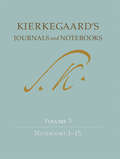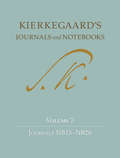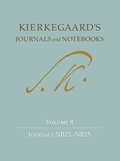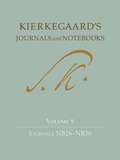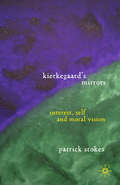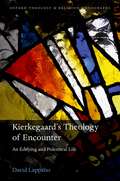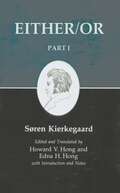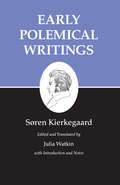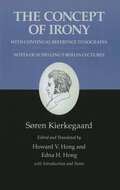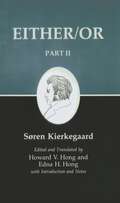- Table View
- List View
Kierkegaard's Journals and Notebooks, Volume 1: Journals AA-DD
by Søren Kierkegaard Bruce H. Kirmmse Niels Jørgen Cappelørn Alastair Hannay George Pattison Jon StewartI would like to write a novel in which the main character would be a man who got a pair of glasses, one lens of which reduced images as powerfully as an oxyhydrogen microscope, and the other of which magnified on the same scale, so that he perceived everything relatively. ? A flight of fancy by an aspiring science fiction writer? While it may sound as such, this wistful musing is one of the little-discussed personal reflections of nineteenth-century philosopher Søren Kierkegaard, whose remarkable journals and notebooks, unpublished during his lifetime, are presented here. The first of an eleven-volume series produced by Copenhagen's Søren Kierkegaard Research Centre, this volume is the first English translation and commentary of Kierkegaard's journals based on up-to-date scholarship. It offers new insight into Kierkegaard's inner life. In addition to early drafts of his published works, the journals contain his thoughts on current events and philosophical and theological matters, notes on books he was reading, miscellaneous jottings, and ideas for future literary projects. Kierkegaard wrote his journals in a two-column format, one for his initial entries and the second for the marginal comments he added later. The new edition of the journals reproduces this format and contains photographs of original manuscript pages, as well as extensive scholarly commentary. Translated by leading experts on Kierkegaard, Journals and Notebooks will become the benchmark for all future Kierkegaard scholarship.
Kierkegaard's Journals and Notebooks, Volume 11, Part 2: Loose Papers, 1843-1855 (Kierkegaard's Journals and Notebooks #17)
by Søren KierkegaardFor over a century, the Danish thinker Søren Kierkegaard (1813–55) has been at the center of a number of important discussions, concerning not only philosophy and theology, but also, more recently, fields such as social thought, psychology, and contemporary aesthetics, especially literary theory.Despite his relatively short life, Kierkegaard was an extraordinarily prolific writer, as attested to by the 26-volume Princeton University Press edition of all of his published writings. But Kierkegaard left behind nearly as much unpublished writing, most of which consists of what are called his "journals and notebooks." Kierkegaard has long been recognized as one of history's great journal keepers, but only rather small portions of his journals and notebooks are what we usually understand by the term "diaries." By far the greater part of Kierkegaard's journals and notebooks consists of reflections on a myriad of subjects—philosophical, religious, political, personal. Studying his journals and notebooks takes us into his workshop, where we can see his entire universe of thought. We can witness the genesis of his published works, to be sure—but we can also see whole galaxies of concepts, new insights, and fragments, large and small, of partially (or almost entirely) completed but unpublished works. Kierkegaard's Journals and Notebooks enables us to see the thinker in dialogue with his times and with himself.Kierkegaard wrote his journals in a two-column format, one for his initial entries and the second for the extensive marginal comments that he added later. This edition of the journals reproduces this format, includes several photographs of original manuscript pages, and contains extensive scholarly commentary on the various entries and on the history of the manuscripts being reproduced.Volume 11, Parts 1 and 2, present an exciting, enlightening, and enormously varied treasure trove of papers that were found, carefully sorted and stored by Kierkegaard himself, in his apartment after his death. These papers—many of which have never before been published in English—provide a window into many different aspects of Kierkegaard's life and creativity. Volume 11, Part 2, includes writings from the period between 1843, the year in which he published his breakthrough Either/Or, and late September 1855, a few weeks before his death, when he recorded his final reflections on "Christendom." Among the highlights are Kierkegaard's famous description of the "Great Earthquake" that shaped his life; his early reflections on becoming an author; his important, though never-delivered, lectures on "The Dialectic of Ethical and Ethical-Religious Communication"; and his final, incandescent assault on the tendency—new in his time—to harness Christianity in support of a specific social and political order.
Kierkegaard's Journals and Notebooks, Volume 2: Journals EE-KK
by Søren Kierkegaard Bruce H. Kirmmse K. Brian Söderquist Niels Jørgen Cappelorn Alastair Hannay David Kangas Vanessa Rumble George PattisonSøren Kierkegaard (1813-55) published an extraordinary number of works during his lifetime, but he left behind nearly as much unpublished writing, most of which consists of what are called his "journals and notebooks." Volume 2 of this 11-volume edition of Kierkegaard's Journals and Notebooks includes materials from 1836 to 1846, a period that takes Kierkegaard from his student days to the peak of his activity as an author. In addition to containing hundreds of Kierkegaard's reflections on philosophy, theology, literature, and his own personal life, these journals are the seedbed of many ideas and passages that later surfaced in Either/Or, Repetition, Fear and Trembling, Philosophical Fragments, The Concept of Anxiety, Stages on Life's Way, Concluding Unscientific Postscript, and a number of Edifying Discourses.
Kierkegaard's Journals and Notebooks, Volume 3: Notebooks 1-15
by Søren Kierkegaard Niels Jørgen Cappelørn Alastair Hannay David Kangas Bruce H. Kirmmse George Pattison Vanessa Rumble K. Brian SöderquistSøren Kierkegaard (1813-55) published an extraordinary number of works during his lifetime, but he left behind nearly as much unpublished writing, most of which consists of what are called his "journals and notebooks." Volume 3 of this 11-volume edition of Kierkegaard's Journals and Notebooks includes Kierkegaard's extensive notes on lectures by the Danish theologian H. N. Clausen and by the German philosopher Schelling, as well as a great many other entries on philosophical, theological, and literary topics. In addition, the volume includes many personal reflections by Kierkegaard, notably those in which he provides an account of his love affair with Regine Olsen, his onetime fiancée.
Kierkegaard's Journals and Notebooks, Volume 4: Journals NB-NB5
by Søren Kierkegaard Niels Jørgen Cappelørn Alastair Hannay David Kangas Bruce H. Kirmmse George Pattison Joel D.S. Rasmussen Vanessa Rumble K. Brian SöderquistFor over a century, the Danish thinker Søren Kierkegaard (1813-55) has been at the center of a number of important discussions, concerning not only philosophy and theology, but also, more recently, fields such as social thought, psychology, and contemporary aesthetics, especially literary theory. Despite his relatively short life, Kierkegaard was an extraordinarily prolific writer, as attested to by the 26-volume Princeton University Press edition of all of his published writings. But Kierkegaard left behind nearly as much unpublished writing, most of which consists of what are called his "journals and notebooks." Kierkegaard has long been recognized as one of history's great journal keepers, but only rather small portions of his journals and notebooks are what we usually understand by the term "diaries." By far the greater part of Kierkegaard's journals and notebooks consists of reflections on a myriad of subjects--philosophical, religious, political, personal. Studying his journals and notebooks takes us into his workshop, where we can see his entire universe of thought. We can witness the genesis of his published works, to be sure--but we can also see whole galaxies of concepts, new insights, and fragments, large and small, of partially (or almost entirely) completed but unpublished works. Kierkegaard's Journals and Notebooks enables us to see the thinker in dialogue with his times and with himself. Volume 4 of this 11-volume series includes the first five of Kierkegaard's well-known "NB" journals, which contain, in addition to a great many reflections on his own life, a wealth of thoughts on theological matters, as well as on Kierkegaard's times, including political developments and the daily press. Kierkegaard wrote his journals in a two-column format, one for his initial entries and the second for the extensive marginal comments that he added later. This edition of the journals reproduces this format, includes several photographs of original manuscript pages, and contains extensive scholarly commentary on the various entries and on the history of the manuscripts being reproduced.
Kierkegaard's Journals and Notebooks, Volume 5: Journals NB6-NB10
by Søren Kierkegaard Niels Jørgen Cappelørn Alastair Hannay David Kangas Bruce H. Kirmmse George Pattison Joel D.S. Rasmussen Vanessa Rumble K. Brian SöderquistFor over a century, the Danish thinker Søren Kierkegaard (1813-55) has been at the center of a number of important discussions, concerning not only philosophy and theology, but also, more recently, fields such as social thought, psychology, and contemporary aesthetics, especially literary theory. Despite his relatively short life, Kierkegaard was an extraordinarily prolific writer, as attested to by the 26-volume Princeton University Press edition of all of his published writings. But Kierkegaard left behind nearly as much unpublished writing, most of which consists of what are called his "journals and notebooks." Kierkegaard has long been recognized as one of history's great journal keepers, but only rather small portions of his journals and notebooks are what we usually understand by the term "diaries." By far the greater part of Kierkegaard's journals and notebooks consists of reflections on a myriad of subjects--philosophical, religious, political, personal. Studying his journals and notebooks takes us into his workshop, where we can see his entire universe of thought. We can witness the genesis of his published works, to be sure--but we can also see whole galaxies of concepts, new insights, and fragments, large and small, of partially (or almost entirely) completed but unpublished works. Kierkegaard's Journals and Notebooks enables us to see the thinker in dialogue with his times and with himself. Volume 5 of this 11-volume series includes five of Kierkegaard's important "NB" journals (Journals NB6 through NB10), covering the months from summer 1848 through early May 1849. This was a turbulent period both in the history of Denmark--which was experiencing the immediate aftermath of revolution and the fall of absolutism, a continuing war with the German states, and the replacement of the State Church with the Danish People's Church--and for Kierkegaard personally. The journals in the present volume include Kierkegaard's reactions to the political upheaval, a retrospective account of his audiences with King Christian VIII, deliberations about publishing an autobiographical explanation of his writings, and an increasingly harsh critique of the Danish Church. These journals also reflect Kierkegaard's deep concern over his collision with the satirical journal Corsair, an experience that helped radicalize his view of "essential Christianity" and caused him to ponder the meaning of martyrdom. Kierkegaard wrote his journals in a two-column format, one for his initial entries and the second for the extensive marginal comments that he added later. This edition of the journals reproduces this format, includes several photographs of original manuscript pages, and contains extensive scholarly commentary on the various entries and on the history of the manuscripts being reproduced.
Kierkegaard's Journals and Notebooks, Volume 6: Journals NB11 - NB14
by Søren Kierkegaard Bruce H. Kirmmse K. Brian Söderquist Niels Jørgen Cappelørn Alastair Hannay David Kangas George Pattison Joel D.S. Rasmussen Vanessa RumbleFor over a century, the Danish thinker Søren Kierkegaard (1813-55) has been at the center of a number of important discussions, concerning not only philosophy and theology, but also, more recently, fields such as social thought, psychology, and contemporary aesthetics, especially literary theory. Despite his relatively short life, Kierkegaard was an extraordinarily prolific writer, as attested to by the 26-volume Princeton University Press edition of all of his published writings. But Kierkegaard left behind nearly as much unpublished writing, most of which consists of what are called his "journals and notebooks." Kierkegaard has long been recognized as one of history's great journal keepers, but only rather small portions of his journals and notebooks are what we usually understand by the term "diaries." By far the greater part of Kierkegaard's journals and notebooks consists of reflections on a myriad of subjects--philosophical, religious, political, personal. Studying his journals and notebooks takes us into his workshop, where we can see his entire universe of thought. We can witness the genesis of his published works, to be sure--but we can also see whole galaxies of concepts, new insights, and fragments, large and small, of partially (or almost entirely) completed but unpublished works. Kierkegaard's Journals and Notebooks enables us to see the thinker in dialogue with his times and with himself. Volume 6 of this 11-volume series includes four of Kierkegaard's important "NB" journals (Journals NB11 through NB14), covering the months from early May 1849 to the beginning of 1850. At this time Denmark was coming to terms with the 1848 revolution that had replaced absolutism with popular sovereignty, while the war with the German states continued, and the country pondered exactly what replacing the old State Church with the Danish People's Church would mean. In these journals Kierkegaard reflects at length on political and, especially, on ecclesiastical developments. His brooding over the ongoing effects of his fight with the satirical journal Corsair continues, and he also examines and re-examines the broader personal and religious significance of his broken engagement with Regine Olsen. These journals also contain reflections by Kierkegaard on a number of his most important works, including the two works written under his "new" pseudonym Anti-Climacus (The Sickness unto Death and Practice in Christianity) and his various attempts at autobiographical explanations of his work. And, all the while, the drumbeat of his radical critique of "Christendom" continues and escalates. Kierkegaard wrote his journals in a two-column format, one for his initial entries and the second for the extensive marginal comments that he added later. This edition of the journals reproduces this format, includes several photographs of original manuscript pages, and contains extensive scholarly commentary on the various entries and on the history of the manuscripts being reproduced.
Kierkegaard’s Journals and Notebooks, Volume 7: Journals NB15-NB20
by Søren Kierkegaard Bruce H. Kirmmse K. Brian Söderquist Niels Jørgen Cappelorn Alastair Hannay George Pattison Vanessa RumbleFor over a century, the Danish thinker Søren Kierkegaard (1813-55) has been at the center of a number of important discussions, concerning not only philosophy and theology, but also, more recently, fields such as social thought, psychology, and contemporary aesthetics, especially literary theory. Despite his relatively short life, Kierkegaard was an extraordinarily prolific writer, as attested to by the 26-volume Princeton University Press edition of all of his published writings. But Kierkegaard left behind nearly as much unpublished writing, most of which consists of what are called his "journals and notebooks." Kierkegaard has long been recognized as one of history's great journal keepers, but only rather small portions of his journals and notebooks are what we usually understand by the term "diaries." By far the greater part of Kierkegaard's journals and notebooks consists of reflections on a myriad of subjects--philosophical, religious, political, personal. Studying his journals and notebooks takes us into his workshop, where we can see his entire universe of thought. We can witness the genesis of his published works, to be sure--but we can also see whole galaxies of concepts, new insights, and fragments, large and small, of partially (or almost entirely) completed but unpublished works. Kierkegaard's Journals and Notebooks enables us to see the thinker in dialogue with his times and with himself. Volume 7 of this 11-volume series includes six of Kierkegaard's important "NB" journals (Journals NB15 through NB20), covering the months from early January 1850 to mid-September of that year. By this time it had become clear that popular sovereignty, ushered in by the revolution of 1848 and ratified by the Danish constitution of 1849, had come to stay, and Kierkegaard now intensified his criticism of the notion that everything, even matters involving the human soul, could be decided by "balloting." He also continued to direct his barbs at the established Danish Church and its clergy (particularly Bishop J. P. Mynster and Professor H. L. Martensen), at the press, and at the attempt by modern philosophy to comprehend the incomprehensibility of faith. Kierkegaard's reading notes include entries on Augustine, the Stoics, German mystics, Luther, pietist authors, and Rousseau, while his autobiographical reflections circle around the question of which, if any, of several essays explaining his life and works he ought to publish. Perhaps unsurprisingly, Kierkegaard's more personal reflections return once again to his public feud with M. A. Goldschmidt and his broken engagement to Regine Olsen. Kierkegaard wrote his journals in a two-column format, one for his initial entries and the second for the extensive marginal comments that he added later. This edition of the journals reproduces this format, includes several photographs of original manuscript pages, and contains extensive scholarly commentary on the various entries and on the history of the manuscripts being reproduced.
Kierkegaard's Journals and Notebooks, Volume 8: Journals NB21–NB25
by Søren Kierkegaard Niels Jørgen Cappelørn Alastair Hannay Bruce H. Kirmmse David D. Possen Joel D.S. Rasmussen Vanessa Rumble Research CentreFor over a century, the Danish thinker Søren Kierkegaard (1813–55) has been at the center of a number of important discussions, concerning not only philosophy and theology, but also, more recently, fields such as social thought, psychology, and contemporary aesthetics, especially literary theory.Despite his relatively short life, Kierkegaard was an extraordinarily prolific writer, as attested to by the 26-volume Princeton University Press edition of all of his published writings. But Kierkegaard left behind nearly as much unpublished writing, most of which consists of what are called his "journals and notebooks." Kierkegaard has long been recognized as one of history's great journal keepers, but only rather small portions of his journals and notebooks are what we usually understand by the term "diaries." By far the greater part of Kierkegaard’s journals and notebooks consists of reflections on a myriad of subjects—philosophical, religious, political, personal. Studying his journals and notebooks takes us into his workshop, where we can see his entire universe of thought. We can witness the genesis of his published works, to be sure—but we can also see whole galaxies of concepts, new insights, and fragments, large and small, of partially (or almost entirely) completed but unpublished works. Kierkegaard’s Journals and Notebooks enables us to see the thinker in dialogue with his times and with himself.Kierkegaard wrote his journals in a two-column format, one for his initial entries and the second for the extensive marginal comments that he added later. This edition of the journals reproduces this format, includes several photographs of original manuscript pages, and contains extensive scholarly commentary on the various entries and on the history of the manuscripts being reproduced.Volume 8 of this 11-volume series includes five of Kierkegaard’s important "NB" journals (Journals NB21 through NB25), which cover the period from September 1850 to June 1852, and which show Kierkegaard alternately in polemical and reflective postures.The polemics emerge principally in Kierkegaard’s opposition to the increasing infiltration of Christianity by worldly concerns, a development that in his view had accelerated significantly in the aftermath of the political and social changes wrought by the Revolution of 1848. Kierkegaard understood the corrupting of Christianity to be in the interest of the powers that be, and he directed his criticism at politicians, the press, and especially the Danish Church itself, particularly church officials who claimed to be "reformers."On the reflective side, Kierkegaard delves into a number of authors and religious figures, some of them for the first time, including Montaigne, Pascal, Seneca, Savonarola, Wesley, and F. W. Newman. These journals also contain Kierkegaard’s thoughts on the decisions surrounding the publication of the "Anti-Climacus" writings: The Sickness unto Death and especially Practice in Christianity.Kierkegaard’s reader gets the sense both of a gathering storm—by the close of the last journal in this volume, the famous "attack on Christendom" is less than three years away—and a certain hesitancy: What needs reforming, Kierkegaard insists, is not "the doctrine" or "the Church," but "existences," i.e., lives.
Kierkegaard's Journals and Notebooks, Volume 9: Journals NB26–NB30
by Søren Kierkegaard Niels Jørgen Cappelørn Alastair Hannay Bruce H. Kirmmse David D. Possen Joel D.S. Rasmussen Vanessa Rumble Research CentreFor over a century, the Danish thinker Søren Kierkegaard (1813–55) has been at the center of a number of important discussions, concerning not only philosophy and theology, but also, more recently, fields such as social thought, psychology, and contemporary aesthetics, especially literary theory.Despite his relatively short life, Kierkegaard was an extraordinarily prolific writer, as attested to by the 26-volume Princeton University Press edition of all of his published writings. But Kierkegaard left behind nearly as much unpublished writing, most of which consists of what are called his "journals and notebooks." Kierkegaard has long been recognized as one of history's great journal keepers, but only rather small portions of his journals and notebooks are what we usually understand by the term “diaries.” By far the greater part of Kierkegaard’s journals and notebooks consists of reflections on a myriad of subjects—philosophical, religious, political, personal. Studying his journals and notebooks takes us into his workshop, where we can see his entire universe of thought. We can witness the genesis of his published works, to be sure—but we can also see whole galaxies of concepts, new insights, and fragments, large and small, of partially (or almost entirely) completed but unpublished works. Kierkegaard’s Journals and Notebooks enables us to see the thinker in dialogue with his times and with himself.Kierkegaard wrote his journals in a two-column format, one for his initial entries and the second for the extensive marginal comments that he added later. This edition of the journals reproduces this format, includes several photographs of original manuscript pages, and contains extensive scholarly commentary on the various entries and on the history of the manuscripts being reproduced.Volume 9 of this 11-volume series includes five of Kierkegaard’s important “NB” journals (Journals NB26 through NB30), which span from June 1852 to August 1854. This period was marked by Kierkegaard’s increasing preoccupation with what he saw as an unbridgeable gulf in Christianity—between the absolute ideal of the religion of the New Testament and the official, state-sanctioned culture of “Christendom,” which, embodied by the Danish People’s Church, Kierkegaard rejected with increasing vehemence. Crucially, Kierkegaard’s nemesis, Bishop Jakob Peter Mynster, died during this period and, in the months following, Kierkegaard can be seen moving inexorably toward the famous “attack on Christendom” with which he ended his life.
Kierkegaard’s Mirrors: Interest, Self, and Moral Vision
by P. StokesWhat is it to see the world, other people, and imagined situations as making personal moral demands of us? What is it to experience stories as speaking to us personally and directly? Kierkegaard's Mirrors explores Kierkegaard's answers to these questions, with a new phenomenological interpretation of Kierkegaardian 'interest'.
Kierkegaard's Muse: The Mystery of Regine Olsen
by Joakim GarffThe first biography of Kierkegaard's literary muse and one-time fiancée, from the author of the definitive biography of the philosopherKierkegaard's Muse, the first biography of Regine Olsen (1822–1904), the literary inspiration and one-time fiancée of Danish philosopher Søren Kierkegaard, is a moving portrait of a long romantic fever that had momentous literary consequences. Drawing on more than one hundred previously unknown letters by Regine that acclaimed Kierkegaard biographer Joakim Garff discovered by chance, the book tells the story of Kierkegaard and Regine's mysterious relationship more fully and vividly than ever before, shedding new light on her influence on his life and writings.Like Dante's Beatrice, Regine is one of the great muses of literary history. Kierkegaard proposed to her in 1840, but broke off the engagement a year later. After their break, they saw each other strikingly often, inside dimly lit churches, on the streets of Copenhagen, and on the paths along the old city ramparts, passing by without uttering a word.Despite or because of their separation in life, Kierkegaard made Regine his literary life companion, "that single individual" to whom he dedicated all his works. Garff shows how Regine became a poetic presence in the frequent erotic conflicts found throughout Kierkegaard's writings, from the famous "Seducer's Diary" account of their relationship to diary entries made shortly before his death in 1855. In turn, Regine remained preoccupied with Kierkegaard until her own death almost fifty years later, and her newly discovered letters, written to her sister Cornelia, reveal for the first time a woman of flesh and blood.A psychologically acute narrative that is as gripping as a novel, Kierkegaard's Muse is an unforgettable account of a wild, strange, and poignant romance that made an indelible mark on literary history.
Kierkegaard's Pseudonymous Authorship: A Study of Time and Self (Princeton Legacy Library #5499)
by Mark C. TaylorThis book deals with a central problem in the writings of Soren Kierkegaard, the themes of time and the self as developed in the pseudonymous writings. Arguing that a most effective way to grasp the unity of Kierkegaard's dialectic of the stages of existence is to focus on the dramatic presentation of time and the self that appears at each stage, Mark C. Taylor pursues these themes from the viewpoints of theology, philosophy, psychology, and related areas of study.The author works from the original texts and makes much use of untranslated primary and secondary material. His concluding evaluation offerse a critical perspective from which to view Kierkegaard's interpretation of time and selfhood and indicates the importance of Kierkegaard's work for our time.Mark C. Taylor teaches religion at Williams College.Originally published in 1975.The Princeton Legacy Library uses the latest print-on-demand technology to again make available previously out-of-print books from the distinguished backlist of Princeton University Press. These editions preserve the original texts of these important books while presenting them in durable paperback and hardcover editions. The goal of the Princeton Legacy Library is to vastly increase access to the rich scholarly heritage found in the thousands of books published by Princeton University Press since its founding in 1905.
Kierkegaard's Relation to Hegel
by Niels Thulstrup George L. StengrenThis book, written by the eminent Kierkegaard scholar Niels Thulstrup, provides the first comprehensive treatment of this issue. Presented here in translation from the Danish, the work makes available materials that heretofore have been nearly inaccessible to most American scholars and to many Europeans as well.Originally published in 1980.The Princeton Legacy Library uses the latest print-on-demand technology to again make available previously out-of-print books from the distinguished backlist of Princeton University Press. These editions preserve the original texts of these important books while presenting them in durable paperback and hardcover editions. The goal of the Princeton Legacy Library is to vastly increase access to the rich scholarly heritage found in the thousands of books published by Princeton University Press since its founding in 1905.
Kierkegaard's Theology of Encounter: An Edifying and Polemical Life (Oxford Theology and Religion Monographs)
by David LappanoKierkegaard's Theology of Encounter provides a theoretical framework that brings the unity of Kierkegaard's 'middle period' into relief. David Lappano analyses Kierkegaard's writings between 1846 and 1852 when the socially constructive dimension of his thought comes to prominence, involving two dialectical aspects of religiousness identified by Kierkegaard: they are the edifying and the polemical. How these come together and get worked out in the lives of individuals form the basis of what can be called a Kierkegaardian 'social praxis'. Lappano argues that the tension between the edifying and the polemical can be coherently maintained in a communicative life that is also characteristic of a militant faith. This militant faith and life is presented as a critical guard against absolutisms, fundamentalisms, and intellectual aloofness; but the 'militant' individual is also utterly dependent, in need of edification and critique, and therefore chooses the risk of encountering others, seeking relationships out of a commitment to the development of people and communities in co-operation. Therefore, not only does this dialectic provide readers with an important theoretical framework for understanding Kierkegaard's 'middle period', it is also a valuable resource for a constructive analysis of active social living suitable for theology in the twenty-first century.
Kierkegaard's Theology of Encounter: An Edifying and Polemical Life (Oxford Theology and Religion Monographs)
by David LappanoKierkegaard's Theology of Encounter provides a theoretical framework that brings the unity of Kierkegaard's 'middle period' into relief. David Lappano analyses Kierkegaard's writings between 1846 and 1852 when the socially constructive dimension of his thought comes to prominence, involving two dialectical aspects of religiousness identified by Kierkegaard: they are the edifying and the polemical. How these come together and get worked out in the lives of individuals form the basis of what can be called a Kierkegaardian 'social praxis'. Lappano argues that the tension between the edifying and the polemical can be coherently maintained in a communicative life that is also characteristic of a militant faith. This militant faith and life is presented as a critical guard against absolutisms, fundamentalisms, and intellectual aloofness; but the 'militant' individual is also utterly dependent, in need of edification and critique, and therefore chooses the risk of encountering others, seeking relationships out of a commitment to the development of people and communities in co-operation. Therefore, not only does this dialectic provide readers with an important theoretical framework for understanding Kierkegaard's 'middle period', it is also a valuable resource for a constructive analysis of active social living suitable for theology in the twenty-first century.
Kierkegaard's Thought
by Gregor Malantschuk Howard V. Hong Edna H. HongKierkegaard's pseudonymous authorship has baffled readers, his apparent capriciousness making it difficult to determine his position at a given point and to understand his work as an organic whole. Gregor Malantschuk's study, based on careful reading of Kierkegaard's journals, papers, and texts, cuts through the authorship problem to clarify the philosopher's key ideas, see the comprehensive plan of his work, and make intelligible the dialectical coherence of his thought. Discussing Kierkegaard's dialectical method and his use of it from Either/Or to the final Two Discourses, Professor Malantschuk shows how coherently Kierkegaard set the individual works in place, so that even the conflict between the principal pseudonyms, Climacus and Anti-Climacus, serves to elucidate his major philosophical ideas. Contents: 1. Anthropological Contemplation. II. Kierkegaard's Dialectical Method. III. The Dialectic Employed in the Authorship. Index.Originally published in 1971.The Princeton Legacy Library uses the latest print-on-demand technology to again make available previously out-of-print books from the distinguished backlist of Princeton University Press. These editions preserve the original texts of these important books while presenting them in durable paperback and hardcover editions. The goal of the Princeton Legacy Library is to vastly increase access to the rich scholarly heritage found in the thousands of books published by Princeton University Press since its founding in 1905.
Kierkegaard's Writing, III, Part I: Either/Or
by Søren Kierkegaard Howard V. Hong Edna H. HongSøren Kierkegaard, the nineteenth-century Danish philosopher rediscovered in the twentieth century, is a major influence in contemporary philosophy, religion, and literature. He regarded Either/Or as the beginning of his authorship, although he had published two earlier works on Hans Christian Andersen and irony. The pseudonymous volumes of Either/Or are the writings of a young man (I) and of Judge William (II). The ironical young man's papers include a collection of sardonic aphorisms; essays on Mozart, modern drama, and boredom; and "The Seducer's Diary." The seeming miscellany is a reflective presentation of aspects of the "either," the esthetic view of life. Part II is an older friend's "or," the ethical life of integrated, authentic personhood, elaborated in discussions of personal becoming and of marriage. The resolution of the "either/or" is left to the reader, for there is no Part III until the appearance of Stages on Life's Way. The poetic-reflective creations of a master stylist and imaginative impersonator, the two men write in distinctive ways appropriate to their respective positions.
Kierkegaard's Writing, III, Part I: Either/Or
by Søren Kierkegaard Howard V. Hong Edna H. HongSøren Kierkegaard, the nineteenth-century Danish philosopher rediscovered in the twentieth century, is a major influence in contemporary philosophy, religion, and literature. He regarded Either/Or as the beginning of his authorship, although he had published two earlier works on Hans Christian Andersen and irony. The pseudonymous volumes of Either/Or are the writings of a young man (I) and of Judge William (II). The ironical young man's papers include a collection of sardonic aphorisms; essays on Mozart, modern drama, and boredom; and "The Seducer's Diary." The seeming miscellany is a reflective presentation of aspects of the "either," the esthetic view of life. Part II is an older friend's "or," the ethical life of integrated, authentic personhood, elaborated in discussions of personal becoming and of marriage. The resolution of the "either/or" is left to the reader, for there is no Part III until the appearance of Stages on Life's Way. The poetic-reflective creations of a master stylist and imaginative impersonator, the two men write in distinctive ways appropriate to their respective positions.
Kierkegaard's Writings, I, Volume 1: Early Polemical Writings
by Søren Kierkegaard Julia WatkinEarly Polemical Writings covers the young Kierkegaard's works from 1834 through 1838. His authorship begins, as it was destined to end, with polemic. Kierkegaard's first published article touches on the theme of women's emancipation, and the other articles from his student years deal with freedom of the press. Modern readers can see the seeds of Kierkegaard's future career these early pieces. In "From the Papers of One Still Living," his review of Hans Christian Andersen's novel Only a Fiddler, Kierkegaard rejects the notion that environment is decisive in determining the fate of genius. He also puts forward his belief that each person needs a life-view or life for which and by which to live, a thought he explores further in the comic play The Battle between the Old and the New Soap-Cellars.
Kierkegaard's Writings, I, Volume 1: Early Polemical Writings
by Søren Kierkegaard Julia WatkinEarly Polemical Writings covers the young Kierkegaard's works from 1834 through 1838. His authorship begins, as it was destined to end, with polemic. Kierkegaard's first published article touches on the theme of women's emancipation, and the other articles from his student years deal with freedom of the press. Modern readers can see the seeds of Kierkegaard's future career these early pieces. In "From the Papers of One Still Living," his review of Hans Christian Andersen's novel Only a Fiddler, Kierkegaard rejects the notion that environment is decisive in determining the fate of genius. He also puts forward his belief that each person needs a life-view or life for which and by which to live, a thought he explores further in the comic play The Battle between the Old and the New Soap-Cellars.
Kierkegaard's Writings, II, Volume 2: The Concept of Irony, with Continual Reference to Socrates/Notes of Schelling's Berlin Lectures
by Søren Kierkegaard Howard V. Hong Edna H. HongA work that "not only treats of irony but is irony," wrote a contemporary reviewer of The Concept of Irony, with Continual Reference to Socrates. Presented here with Kierkegaard's notes of the celebrated Berlin lectures on "positive philosophy" by F.W.J. Schelling, the book is a seedbed of Kierkegaard's subsequent work, both stylistically and thematically. Part One concentrates on Socrates, the master ironist, as interpreted by Xenophon, Plato, and Aristophanes, with a word on Hegel and Hegelian categories. Part Two is a more synoptic discussion of the concept of irony in Kierkegaard's categories, with examples from other philosophers and with particular attention given to A. W. Schlegel's novel Lucinde as an epitome of romantic irony. The Concept of Irony and the Notes of Schelling's Berlin Lectures belong to the momentous year 1841, which included not only the completion of Kierkegaard's university work and his sojourn in Berlin, but also the end of his engagement to Regine Olsen and the initial writing of Either/Or.
Kierkegaard's Writings, II, Volume 2: The Concept of Irony, with Continual Reference to Socrates/Notes of Schelling's Berlin Lectures
by Søren Kierkegaard Howard V. Hong Edna H. HongA work that "not only treats of irony but is irony," wrote a contemporary reviewer of The Concept of Irony, with Continual Reference to Socrates. Presented here with Kierkegaard's notes of the celebrated Berlin lectures on "positive philosophy" by F.W.J. Schelling, the book is a seedbed of Kierkegaard's subsequent work, both stylistically and thematically. Part One concentrates on Socrates, the master ironist, as interpreted by Xenophon, Plato, and Aristophanes, with a word on Hegel and Hegelian categories. Part Two is a more synoptic discussion of the concept of irony in Kierkegaard's categories, with examples from other philosophers and with particular attention given to A. W. Schlegel's novel Lucinde as an epitome of romantic irony. The Concept of Irony and the Notes of Schelling's Berlin Lectures belong to the momentous year 1841, which included not only the completion of Kierkegaard's university work and his sojourn in Berlin, but also the end of his engagement to Regine Olsen and the initial writing of Either/Or.
Kierkegaard's Writings IV, Part II: Either/Or
by Søren Kierkegaard Howard V. Hong Edna H. HongSøren Kierkegaard, the nineteenth-century Danish philosopher rediscovered in the twentieth century, is a major influence in contemporary philosophy, religion, and literature. He regarded Either/Or as the beginning of his authorship, although he had published two earlier works on Hans Christian Andersen and irony. The pseudonymous volumes of Either/Or are the writings of a young man (I) and of Judge William (II). The ironical young man's papers include a collection of sardonic aphorisms; essays on Mozart, modern drama, and boredom; and "The Seducer's Diary." The seeming miscellany is a reflective presentation of aspects of the "either," the esthetic view of life. Part II is an older friend's "or," the ethical life of integrated, authentic personhood, elaborated in discussions of personal becoming and of marriage. The resolution of the "either/or" is left to the reader, for there is no Part III until the appearance of Stages on Life's Way. The poetic-reflective creations of a master stylist and imaginative impersonator, the two men write in distinctive ways appropriate to their respective positions.
Kierkegaard's Writings IV, Part II: Either/Or
by Søren Kierkegaard Howard V. Hong Edna H. HongSøren Kierkegaard, the nineteenth-century Danish philosopher rediscovered in the twentieth century, is a major influence in contemporary philosophy, religion, and literature. He regarded Either/Or as the beginning of his authorship, although he had published two earlier works on Hans Christian Andersen and irony. The pseudonymous volumes of Either/Or are the writings of a young man (I) and of Judge William (II). The ironical young man's papers include a collection of sardonic aphorisms; essays on Mozart, modern drama, and boredom; and "The Seducer's Diary." The seeming miscellany is a reflective presentation of aspects of the "either," the esthetic view of life. Part II is an older friend's "or," the ethical life of integrated, authentic personhood, elaborated in discussions of personal becoming and of marriage. The resolution of the "either/or" is left to the reader, for there is no Part III until the appearance of Stages on Life's Way. The poetic-reflective creations of a master stylist and imaginative impersonator, the two men write in distinctive ways appropriate to their respective positions.



